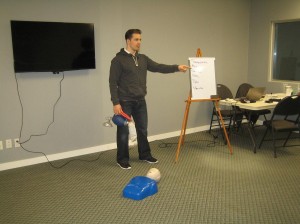Seattle CPR is one of the top training providers of CPR programs in Seattle, Washington. A number of classes on CPR are available through the week, sometimes during the evenings and weekends when regular class schedules cannot accommodate all the trainees. People who need quality certification can sign up for any of our programs and receive their credentials once they finish all the lessons and program requirements. There are several ways to enrol for a training program, the easiest way can be found on the Seattle CPR homepage, with the application form. Complete contact details as well as the address of the training center are on the website as well, if the trainee decides to send his or her enrolment through e-mail or over the telephone.
Becoming a trained CPR rescuer
There are a total of five BLS and ALS programs at Seattle CPR, three of them with available re-certification. Re-certification classes are used to renew nearly expired credentials. Any certificates awarded from any of our training programs are valid for only two years. Before they expire, rescuers have to sign up for re-certification to renew them for another 2 years. Expired credentials are not honored at Seattle CPR. If the certificate expires and the rescuer wants to renew it, he or she has to retake the entire program.
Basic Life Support programs

Basic Life Support programs teach trainees basic CPR skills needed during a one-person rescue. Basic CPR skills include how to give compressions and rescue breaths and how to use defibrillators. All of the BLS programs include first aid skill training as well, primarily the Heimlich maneuver and wound care. BLs programs teach students how to recognize and reaction to a cardiorespiratory emergency in a non-clinical setting. There are three BLS programs offered by Seattle CPR, one for the general public and two for healthcare providers. Basic CPR programs teach one-person CPR rescue while BLS training teaches one and two-person CPR rescue.
- Basic CPR and AED training – general public, 4 hours (no re-certification class)
- Basic CPR and AED training (C) – healthcare providers, 4 hours (no re-certification class)
- Basic Life Support training – healthcare providers, 4.5 hours (re-certification 4 hours)
Advanced Life Support programs
While the BLS programs teach students basic CPR skills, ALS programs teach students how to manage cardiac arrest in a clinical setting. Students are introduced to the crash cart, a moveable cabinet with complete equipment and medications for managing a code. A code refers to a patient who experiencing cardiopulmonary distress and is going into cardiac arrest. Both one and two-person rescues are taught in the program. To qualify for any of the two ALS programs, students are required to have a valid BLS training certificate.
ACLS training is for adult victims of cardiac arrest while PALS training is for pediatric victims. Giving CPR to an infant and younger child is very different from giving CPR to an adult, especially when it comes to medication as well as assessment.
- Advanced Cardiac Life Support – healthcare providers, 16 hours over two days (re-certification 5-6 hours)
- Pediatric Advanced Life Support – healthcare providers, 14 hours over two days (re-certification 6-8 hours)